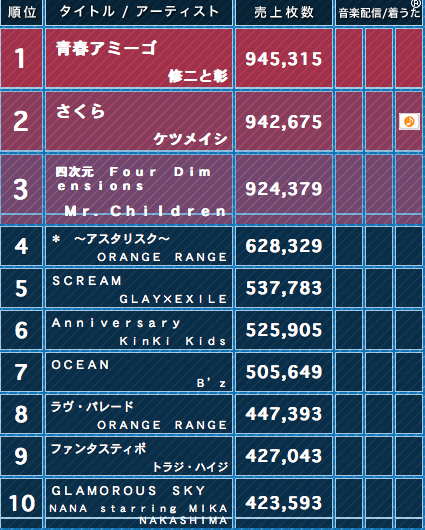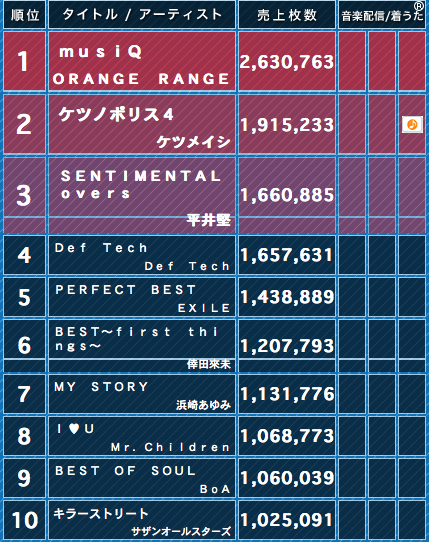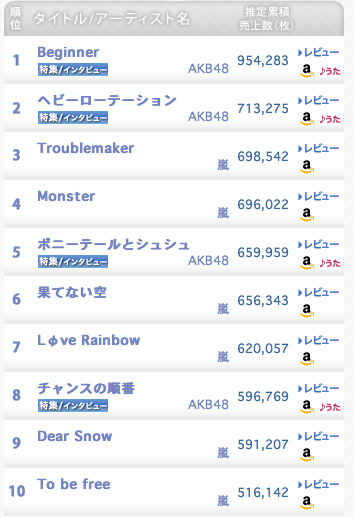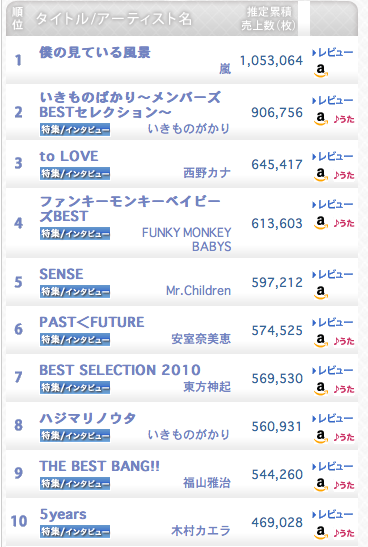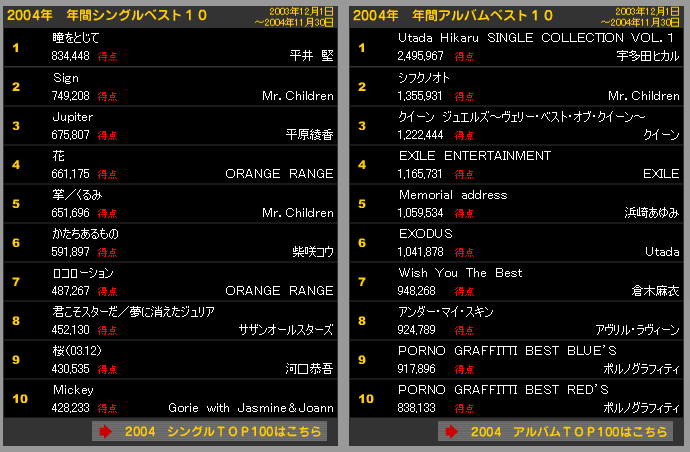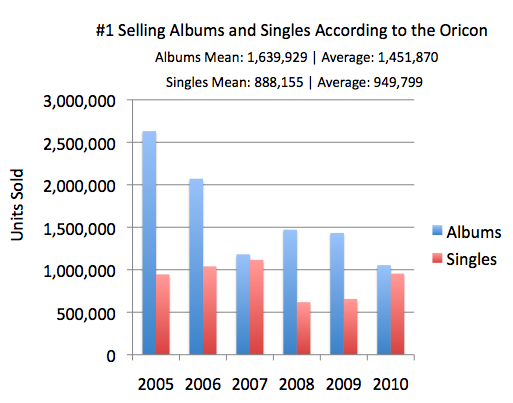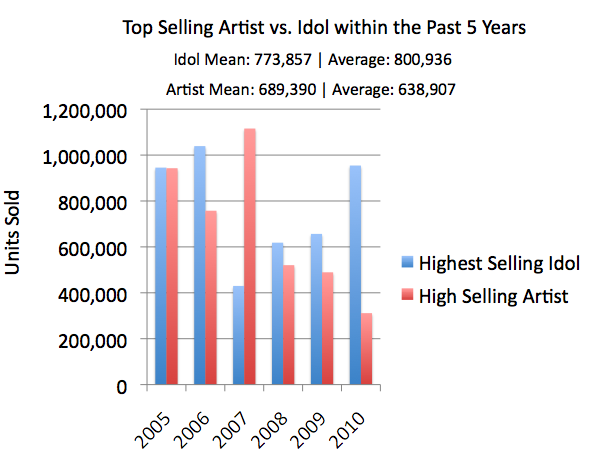What Happened to the Music Industry, Japan?
What happened, Japan? What happened to that music industry that used to have artists like GLAY, Koda Kumi, Orange Range, and Mr. Children in the top 10 yearly ranking?
You used to be so great. There was always something new to look forward too, new musicians to break out with something innovative, and an idol industry that restrained itself. It was normal to catch rock bands in the top 10 and solo female artists without an troupe of fifteen others dancing behind them. Singer/Songwriters actually had careers, some getting lucky and finding success while others managed to at least get record contracts.
So what happened, Music Industry of Japan? When did the music turn into a cash cow market of marketing gimmicks and CD sales? Well, since you won’t tell me, I guess I have to go out and dig myself.
Above is the Oricon charts for the top 10 sold singles and albums of 2005. Below is the charts for the top 10 sold singles and albums of 2010.
Notice something? Yeah? I do too.
In 2010 a record was smashed by AKB48 and ARASHI, two mega idol groups. Continuing from their success from the previous years, ARASHI was pretty much celebrating their 20th anniversary, a year later while AKB48 came out with a slam hit called Beginner. They were the only two “artists” to dominate the top ten most sold singles of 2010.
Five years ago, that would have been unheard of.
As you notice, in 2005, there was a balance. Johnny’s unit, Akira to Shuji, managed to score no. 1 for the year, followed by the hip hop group Keshimeshi. Mr. Children followed after with Orange Range, Johnny’s unit TorajixHaiji, GLAY, Kinki Kids, B’z, and Mika Nakashima rounding out the chart. This was not uncommon then. It was always a race to find out what artist was going to make the top ten, not what idol group was going to dominate the charts.
Even going back to 2004, you did not see such things happen on the Oricon charts. Ken Hirai, Mr. Children, and Ayaka Hirahara were the top 3 selling artists of that year. Some of you probably don’t even know who Ayaka Hirahara is. It’s okay, she hasn’t had a top twenty hit since 2006 (she’s amazing though). Going back to 2003, 2002, or even ten years ago, things like that never happened in the music industry. So where did it go? Why are the singers no longer ranking on the charts? When did the idol machine come in and dominate the music industry to the point that the only singer/songwriters in the top 20 singles sold in 2010 are only Sakamoto Fuyumi and Fukuyama Masaharu?
Let’s Talk Numbers
It seems like the easiest way to break this down is to talk numbers. Take a look at the album sales from 2005 to 2010. Orange Range’s musiQ had the top selling album of 2005, selling over 2 million units. What was the top selling album of 2010? Arashi’s Boku no Miteiru Fuukei with a million units sold.
There’s a 1,577,699 unit difference between the top selling albums of 2005 and 2010. That’s a huge decrease in sales. A major decrease in sales. Let’s use a pie chart to illustrate the decrease in numbers:
From 2005 through 2006 album units sold stayed above 2 million, in 2007 there was a sharp decrease of around 500k units, but jumping back up in 2008 and 2009 to drop again another 500k in 2010. Numbers rounded, of course. Fortunately enough, single sales managed to stay the same despite the sharp drop in 2008 and 2009. There are many factors that can attribute to the steady decline in sales, such as the turn of the economy in 2008, but, there’s a little bit more that plays into it as well.
So am I to say that the drop in sales made it easier for the Idol machine to come and snatch the top spot so easily? Not necessarily but it plays a huge part in how artists like Mr. Children are beat out by acts such as AKB48. There has to be a reason why the singer/songwriter is loosing out to the idol.
As always, there has always been a significant different in sales between the idol and the singer. As this chart shows in a five year period,
Only in the years of 2005 and 2007 did an artist manage to beat an artist with units sold. Looking at the chart, you will notice a steady increase in idol unit sales compared to the artist.
So, how does the idol manage to beat the artist? Well, it goes to how the units are being sold.
Limited Editions, Versions, and Marketing Gimmicks
It comes with the territory. As an idol you’re expected to have posters, trading cards, games, T-shirts, television shows, books, magazines, CDs, DVDs, and the kitchen sink to sell to the teenage-young adult demographic. They are an idol, a perfect human being meant to entertain the masses. A product.
Artists on the other hand are musicians. They sing because its their craft, its what they use to express themselves. Its what they have to support themselves. Concerts are usually the only form of revenue for a lot in the industry, with the occasional good to signify the release of a new album or single.
If the artist fails to sell, the artist looses his record deal. If an idol begins to slip, they’re re-imagined, repackaged, and reintroduced until they’re too old (25 if a woman, 30 if a man) to continue.
So what does the industry do when the economy is crashing around them and sales are dropping? You introduce multiple versions of the same product.
Let’s look at the top selling single of 2010, AKB48’s ” Beginner “. When released, there was four different versions available. Two standards and two limited editions. That is four separate units with four different product ID numbers. All were counted towards the general sale of that single. The single sold 954,283 units for that year.
If we do some basic math here by dividing 4 into 954,283 we get a number of 238,570. This number would be a hypothetical representation how many units sold if there was only one version and the same amount of people bought a copy.
Multiple versions boost sales. Marketing gimmicks boost sales. For instance, the only reason why Kanjani8’s Kanfuu Fighting was the 9th highest selling song of 2007 was not because of the quality of the single (the lyrics are stupid and the instrumental is lame) but because there was 8 versions of the same song. Each “limited edition” single contained a cell phone strap specific to each member’s image color. Had there only been one version of the single, it probably would have sold roughly around 110k, year end.
Idol groups appeal to the collector and agencies love to exploit this to their on monetary advantage. You want the B-sides? Well, you won’t get them on the regular edition! That came with the photobook; you’re going to have to cough up another 16 dollars to get the B-sides and if you want the music video DVD you’re going to have to cough up another 16 to get your hands on that.
At the end of the day the fan would have spent close to 48 dollars. If you multiply that 48 dollars by 100,000 fans you would get 4,800,000 dollars in revenue. That would be 400,000 units sold. The idol would not see that money, though. They are, of course, salaried to their talent agencies.
Sam Walton would be proud, Johnny Kitagawa
The idol industry exists to make money and like a Wal-mart coming into town to destroy competition, the Idol industry has expanded to kill its competition and boost its sales.
Now its about breaking Oricon records and getting high numbers. Every other week a Johnny or a AKB48 branch unit manages to break some unbeatable 30 year record. But how else do they do this? Well, let’s look at the agency that is the kings of monopolizing the Oricon: Johnny’s and Associates.
Johnny’s and Associates never schedules a release against a top producing artist. Never. Unless the group is a low producing unit on its own, you will never find Arashi going against Ayumi Hamasaki or Mr. Children. Johnny’s will always release their single on a day that would prohibit competition.
To make a point, ARASHI’s Troublemaker was the third top selling single of 2010 with around 650,000 units sold. The week of it’s release, the group’s competition was visual kei band Sid, idol united Berryz Kubou, and singer Kuraki Mai. None of which would be able to provide an actual competition against Arashi for sales. It would be an easy sweep for the no. 1 spot.
And never will Johnny’s place two of their talents against each other. That would simply be competition. If SMAP and ARASHI were to release on the same day, SMAP would dominate ARASHI for the no. 1 spot. But, then again, that would not stop Johnny’s from having their artists release three consecutive singles in one week… as what they did with Kanjani8’s limited edition Gift singles.
It has been said that Nakai of SMAP once said that the success of SMAP was not due to their singing ability but due to their television presence and if they continued to maintain that presence then they will continue to be popular. This meant stepping out of the music variety programs of the 80s and actually hosting their own programs and starring in dramas and movies.
The Johnny was revolutionized with SMAP and that formula carried on, expanding, and growing. No longer were idols simply singing on Yoru no Hit Studio, going to handshake events, appearing in magazines, and releasing the occasional photobook. They were appearing in dramas, singing the theme songs for said drama, becoming news anchors, television hosts, sports commentators, stage actors, authors, artists, etc.
The idol became the 24/7 Wal-Mart Supercenter.
But, here’s an optimistic approach
Perhaps its not the record industry turning into shit. Maybe the consumer has changed within the past five years. As more and more online shops release their sales data to the Oricon, the sales have also changed.
It is almost fact that foreign fans of Japanese music only know of Japanese idols and artists that have sung for their favorite anime. With shops like CDJapan and YesAsia now reporting to the Oricon, you have domestic purchases and foreign purchases being calculated to the Oricon rankings which would, ultimately, tip the balance in a way.
For the Porno Graffiti five foreign fans out there, there will be about hundred ARASHI foreign fans adding to the numbers. It is not an exaggeration when I say that international fandom has grown to a point where it could potentially have a chance of tipping the charts.
Recently, Johnny’s and Associates opened up an International division catering to their foreign fans. They’ve now given foreign fans access to many once domestic exclusives, such as J-web and the ability to ballot for tickets. Female idol groups, such as AKB48, have been focusing their efforts in Southeast Asia. The idol industry knows that there are devoted fans outside of Japan and are willing to connect to maintain interest and build up their consumer base.
And you can’t blame it on the Hallyu Wave
Japan’s music industry is defaulting itself to the quickest buck. Eventually this idol train will slow down, derail itself, and a new trend will arise from the explosion and debris. Much like the end of the 80s, where the Matsuda Seikos were replaced by the guitars of CHAGE and ASKA, the smooth vocals of Dreams Come True, the visuals of Luna Sea and the catchy pianos of Kan; the Japanese music industry will reinvent itself.
It always had and it always will. But right now, this is a low point. Undoubtedly so. The Hallyu Wave has taken off because it gives foreign fandom what the Jmusic industry used to give. There’s no more Utada Hikarus to tell us its automatic or DA PUMPs to ask us if we’re gonna be their girl. No, that no longer exists. We now have AKB48s running around on sunny beaches in their little bikinis and ARASHIs dancing out of synch and off beat to out dated pop tracks written by Swedish pop writers.
I mean, as long as they look pretty that’s all that matters, right.
Right?
